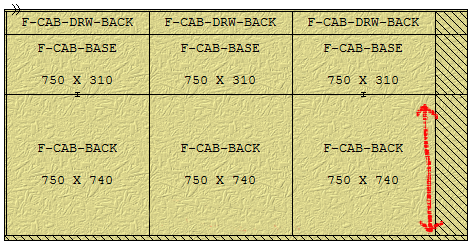

Specification and limits for the device
- The device has three clamping fingers of 15mm with an inter-finger distance of 35mm. The finger midpoints are 50mm, 100mm and 150mm from the angle fence. The overall width of the device is typically 175mm.
- Strips must be clamped by at least one whole finger
- If the first strip set is less than the width of the device the main program fence cannot push another strip set (since this would hit the box sides of the device
- for single Homag/Holzma saws (saw model 21) only
Cutting operations
- Program assumes that a single strip can be clamped on its own, whatever its size.
- If the last strip set is being pushed by the device alone, the main program fence can begin the rip infeed for the next book (as long as there are no recuts to process and there is more than one cycle); the saw simulation changes to a two level display (similar to an angular saw), so that the simultaneous operation can be seen.
- Where the width of the first set of strips exceeds the Max width of strip set the device then acts as an ordinary fixed clamp.
- Where the device allows simultaneous crosscutting of strips with different cuts, the number of crosscuts and cutting time is calculated by using the most complex strip as a template.
Recuts
A Homag/Holzma single saw (model 21) with a Power Concept Device can simultaneously divide two recut blocks which have different cuts. This can lead to lower cutting times for pattern with more than one recut block.
- Recut blocks are divided at the end of the pattern. Only single / multiple recuts are considered. Recuts at the uneven and lower levels are not combined.
- Recut blocks are stacked in the order removed from the saw and processed in reverse calculating whether a recut block can be divided simultaneously with the next in the stack.
Clamping rules
Where there is a Power Concept (PCD) or a Multi-axis saw with multiple program fences the program ensures a new set of strips is only assigned to a fence where the fence is not obstructed by the strip on the previous fence.
Sorting
With a Power concept device the pattern strips are sorted to maximise the number of pairs of strips that can be cut at the same time.
Minimum width of strip to clamp
This is calculated using the Power concept device saw parameters. The minimum width that can be clamped corresponds to the mid-point of the first finger on the clamp.
Clamp position = 100 mm
Finger width = 15 mm
Clamp width = 115 mm
Minimum width of strip to clamp = (100 - 115/2) + 15/2 = 50mm
Locked to fence
There are situations where the saw controller can 'lock' the PCD to the program fence. This effectively makes the PCD an extension of the fence and allows side-by-side cutting of strips (which have the same crosscuts) which would not normally be possible, for example, where the strip width exceeds the normal strip width limit for the device.

In the above example, the first strip is wider than the maximum width allowed by the PCD (600mm in this example) so this would normally have to be cut on its own. However, the next two strips have the same crosscuts as the first, so, by locking the PCD to the fence, all three strips can be crosscut together rather than in three separate sets.
The PCD and program fence can be locked / unlocked during the pattern cycle, depending upon the requirements of the current strip set.
|
|